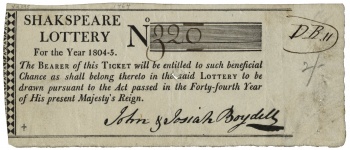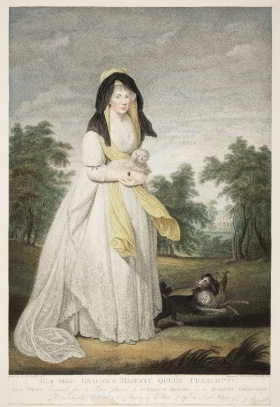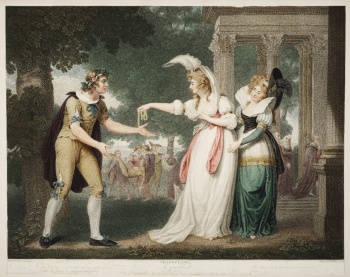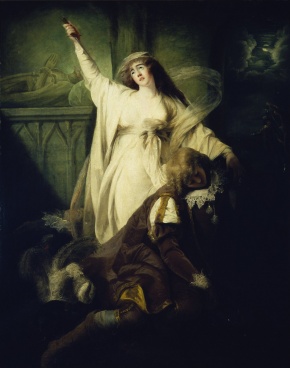Marketing Shakespeare: the Boydell Gallery, 1789–1805, & Beyond

Marketing Shakespeare: the Boydell Gallery, 1789–1805, & Beyond, one of the Exhibitions at the Folger, opened on September 20, 2007 and closed on January 5, 2008. It was curated by Ann R. Hawkins and Georgianna Ziegler.
To enter London’s fashionable Shakespeare Gallery, visitors would have passed under a sculpture depicting William Shakespeare flanked by the Dramatic Muse and the Genius of Painting. Visitors entered a space designed to display and sell scenes from Shakespeare illustrated by the most famous painters of the day. After visiting the Gallery, well-to-do patrons might have subscribed to Boydell’s National Edition, an illustrated scholarly edition of Shakespeare’s work. Or visitors may have purchased an engraving of their favorite Shakespearean scene.
The Gallery’s founder, John Boydell (1719–1804), made his fortune by providing engraved prints from famous collections of art, then selling the prints in England and abroad. A savvy salesman, successful politician, and well-known patron of the arts, Boydell determined late in life to foster the improvement of British history painting. Boydell commissioned artists like Sir Joshua Reynolds, Henri Fuseli, and Angelica Kauffman to create works inspired by scenes in Shakespeare, and designed a gallery to display the paintings. He also published engravings of the paintings as illustrations for his edition of Shakespeare's plays. This exhibition chronicles the development of the Shakespeare Gallery—Boydell’s most famous and influential commercial endeavor—a venture that existed at the junction of book and canvas, commerce and art.
Exhibition materials
Listen to co-curator Ann R. Hawkins discuss the The Alto Relievo in front of the Shakespeare Gallery (1796).
Boydell's London

Shakespeare’s popularity rose across the eighteenth century, but particularly after the Shakespeare Jubilee held in Stratford-upon-Avon in 1769. Masterminded by David Garrick, a popular actor and manager of London’s Drury Lane theatre, the Shakespeare Jubilee prompted the manufacture of many Shakespearean products, from vases and snuff boxes to figurines and ceramic tiles, all honoring Shakespeare and the actors who brought his works to life.
The late eighteenth century also saw England becoming the economic powerhouse of Europe. But in the arts, many felt that England lagged behind the continent, both in terms of the quality of production and of the national taste. One such person was John Boydell, a prominent print seller, publisher, and politician who was elected Alderman for Cheapside in 1782, Sheriff of London in 1785, and Lord Mayor of London in 1790.
Listen to co-curator Ann Hawkins discuss Queen Charlotte, the mad king's wife.
Items included
- Henry Meyer after Gilbert Stuart. John Boydell, Esq., Alderman of London. Engraving, 1814. Call number: ART Flat a5 no.2.
- John Boydell. A collection of prints, from pictures painted for the purpose of illustrating the dramatic works of Shakspeare, by the artists of Great-Britain. London: Published by John and Josiah Boydell: Printed by W. Bulmer, 1803. Call number: ART Flat b1-2 copy 1 v.1; displayed Engraved, handcolored frontispiece. King George the Third (1804).
- Thomas Ryder Jr. and Sr. after Sir William Beechey. Her Most Gracious Majesty, Queen Charlotte. Color engraving, 1804. Handcolored frontispiece in John Boydell's A collection of prints, from pictures painted for the purpose of illustrating the dramatic works of Shakspeare, by the artists of Great-Britain. London: Published by John and Josiah Boydell: Printed by W. Bulmer, 1803. Call number: ART Flat b1-2 copy 1 v.2 and LUNA Digital Image.
The Formation of the Gallery: "To Form A School of English Historical Painting"
Boydell realized early in his career that the inferior skill of English engravers limited the market for British prints exported to the continent. By paying significantly higher fees for commissioned engravings, Boydell hoped to foster native products to compete with European prints on the continental market. So successful was he that in 1773, the Royal Academy of Arts awarded Boydell a gold medal for raising the standard of English engraving.
By 1789, after almost fifty years in the print trade, Boydell could claim in his preface to the Catalogue of the Pictures in the Shakspeare Gallery that English engraving had achieved “the perfection of the art.” But Boydell was less sanguine about English painting which, still in its “infancy,” focused more on the provincial (portrait painting) than on the universal (history painting).
To promote a school of British history painting and improve the national taste, Boydell needed a rich subject matter. It had to be filled with a variety of interesting scenes suitable for depiction in painting; and it had to be widely valued and easily recognized as significant both by Boydell’s countrymen and by purchasers in foreign markets.
Boydell chose the “immortal” William Shakespeare for his “grand design.” While to us Boydell’s choice might seem obvious, at the time other likely subjects included John Milton, Edmund Spenser, or the Bible. Boydell argued that Shakespeare’s “creative imagination” gave him an exceptional force to match and surpass the bounds of Nature, the power to “do things that Nature would have done, had she ov’rstepp’d her natural limits.”
Boydell’s plan was ambitious, both in time and cost. Though other publishers had produced editions of Shakespeare’s plays, Boydell wished to create an illustrated scholarly edition. This involved commissioning paintings of scenes from Shakespeare, then sending those paintings to engravers who would create the plates from which illustrations could be printed. After the engraver finished making the plates, the paintings were returned to Boydell for exhibition in a specially-designed gallery, which served as an advance advertisement for the engravings themselves and for the edition they would illustrate.
Although this painting by George Romney is not featured in the exhibition, this item from the Folger's collection is related to the Boydell enterprise. At one point, subscribers were offered as an alternate engraving a print of the large-scale painting of this scene.
Items included
- Francis Wheatley. Helena and Count Bertram before the King of France. Oil on canvas, 1793. Call number: FPa85 and LUNA Digital Image.
- William Hamilton. Isabella appealing to Angelo. Oil on canvas, 1793. Call number: FPa30 and LUNA Digital Image.
- William Hamilton. Olivia's Proposal. Oil on canvas, ca. 1796. Call number: FPa31 and LUNA Digital Image.
Opening the Gallery

Boydell opened the Shakspeare Gallery in Pall Mall, one of London’s most sophisticated neighborhoods, in the fall social season of 1789—less than three years from the date of his advertisement. On the walls were thirty-four paintings from twenty-one plays. Since subscribers received free tickets to view the paintings, the Gallery became a fashionable place to see and be seen. By 1791 it had already grown to seventy-two paintings, the number Boydell had projected it would contain when complete. But Boydell wasn’t finished yet: by 1802 the Gallery contained more than 160 images.
The Creation of the Gallery
In the course of creating the National Edition, Boydell commissioned paintings from the leading artists of the day. Most prominent among them were Joshua Reynolds (then President of the Royal Academy), Angelica Kauffmann, Benjamin West, George Romney, and Henry Fuseli. Romney ultimately did not paint an image from Shakespeare’s plays, but contributed the famous painting, The Infant Shakespeare Attended by Nature and the Passions.
The engravers were among the most skilled in the marketplace, and the advertisements for subscribers list eighteen engravers by name, including Caroline Watson, Francesco Bartolozzi, James Collier, and James Heath. Significantly, the engravers typically received far more money to engrave the paintings than the artists received to paint them. Henry Fuseli received £210 for painting a scene from The Tempest, while Peter Simon received £315 to engrave it.
Almost as an afterthought, Boydell determined to display the paintings in a building specially designed to house them called the Shakspeare Gallery. Boydell purchased fashionable new premises for the Gallery at 52 Pall Mall. Above the door, a large alto relievo (high-relief) sculpture by Thomas Banks depicted Shakespeare standing between the Dramatic Muse and the Genius of Painting. Inside the Gallery, paintings for the National Edition hung on the upper floor as well as three basso relievo (low-relief) sculptures by Anne Damer, which depicted scenes from Antony and Cleopatra and Coriolanus. On the lower floor, visitors could buy engravings of their favorite images. Subscribers to the National Edition received free admission to the Gallery, but it became a popular destination for many others and a lasting mark of Boydell’s fame.
Boydell's Exhibition Guides
Each year, Boydell printed and sold a guide to his exhibition of the paintings for the National Edition. The catalogue offered viewers information about the scenes depicted: play title, act and scene, characters, and most usefully a long excerpt from the scene. As indicated by printer's marks, Boydell often had to reprint catalogs in the middle of the exhibition season, suggesting that attendance at the Gallery was strong.
Encouraged by the "bold design" of the Shakspeare Gallery, The Bee discusses every painting in the 1789 exhibition, offering a brief synopsis of the scene, then some gentle criticism and thoughtful suggestions for improvement. The criticism is meant to help "every painter become a BEE of the same hive, working to the same great end-the advancement and perfection of his Art."
Items included
- John Downman and William Leney. As You Like It, Act 1, scene 2. London, 1800. In John Boydell's A collection of prints, from pictures painted for the purpose of illustrating the dramatic works of Shakspeare, by the artists of Great-Britain. London: Published by John and Josiah Boydell: Printed by W. Bulmer, 1803. Call number: ART Flat b1-2 copy 1 vol.1, plate 24 and LUNA Digital Image.
- John Boydell. A catalogue of the pictures, &c. in the Shakspeare Gallery, Pall-Mall. London, 1796. Call number: PR2883.B7 1796 Cage; displayed pp. 74–75.
- Humphrey Repton. The Bee; or, A companion to the Shakespeare gallery. London, 1789. Call number: PR2883.B7 1789a Cage; displayed title page.
The Progress of a Print
Although it is possible to create an entirely "pure" engraving, where every line is cut into the plate by hand, in practice, commercial engravings like Boydell's typically began with an underlying etching, as seen in this early proof state (upper image), printed before even all the etching was finished. Etching is considerably faster than engraving: instead of cutting lines into the copper by hand, corrosive acid does the work. Using an etching needle on a copper plate covered with varnish, the printmaker scratches the design into the varnish, exposing the copper. When placed in an acid bath, the varnished parts remain pristine, but the exposed copper is eaten away, creating grooves to hold the ink.
After verifying the basic outlines of the design by taking proof impressions from the etched state, the printmaker would continue to work on the plate, adding engraved lines and taking progressive proofs as necessary to check on the work in progress. Compare this finished print to the early proof. Etched lines, with their rounded ends and somewhat shaky feel, are still clearly visible, particularly in the background. Stronger engraved lines, characteristically swelling in the middle before reaching a sharp point at the end, make up the bulk of the figures.
Listen to co-curator Ann R. Hawkins discuss turning an oil painting into an engraving.
Items included
- William Charles Wilson after Richard Westall. King Henry VIII, Act 3, scene 2. Engraving, proof state. London, 1796. Call number: ART Vol. f89 and LUNA Digital Image.
- William Charles Wilson after Richard Westall. King Henry VIII, Act 3, scene 2. Engraving, London, 1796. Call number: ART Vol. f89 and LUNA Digital Image.
Influences from the Stage
Though many of Boydell’s artists called upon their own imaginations for their depictions of scenes, just as many drew on their experiences as playgoers. Especially popular were celebrity actors in signature roles, such as Dorothy Jordan in As You Like It, Sarah Siddons and her brother Charles Kemble in Macbeth.
The Performances of Sarah Siddons
Sarah Siddons, née Kemble (1755–1831), was celebrated for her acting in serious roles. She made her fame portraying Shakespeare’s Volumnia from Coriolanus, Constance from King John, and particularly Lady Macbeth. Sir Joshua Reynolds (1723–1792) painted her as the “Tragic Muse”; and William Hazlitt (1778–1830) called her “tragedy personified.” After her retirement from the stage in 1812, she performed readings and taught elocution to the royal children.
Mrs. Siddons' performances not only awed audiences, but inspired the greatest artists of the time. Drawn from Mrs. Siddons’s powerful portrayal of Lady Macbeth, this illustration depicts her invocation of “spirits” to “unsex” her in order to fill her with “direst cruelty.” This scene allowed Siddons to demonstrate Lady Macbeth’s strength in startling contrast to her later remorse. In 1812, when Siddons retired from the stage in a performance as Lady Macbeth, the audience applauded so long after her sleepwalking scene, that Siddons ended the performance at this stellar moment.
In this preliminary sketch to his painting for Boydell, the well-known artist Richard Westall captures the emotion of Lady Macbeth’s remorse, in her open, but unseeing eyes, and her hands held out from her body. Rubbing her hands to remove the spots of Duncan’s blood that haunt her, Lady Macbeth is observed with concern by the Doctor and a Gentlewoman. Westall’s painting of Lady Macbeth is one of twenty-three paintings he contributed to the Gallery, four of which are scenes from Macbeth.
Once attributed to Shakspeare Gallery artist Robert Smirke, this oil painting shows Lady Macbeth reaching to take the dagger from her husband’s hand, after he has murdered Duncan. The facial profile and overall bearing of Lady Macbeth suggest Mrs. Siddons, who famously performed the role from 1785 until her retirement in 1812.
Items included
- Portrait of Sarah Siddons. Multi-colored enamel, 1798. Call number: 241354 ART.
- James Parker after Richard Westall. Macbeth. Act I. Scene V. Macbeth's Castle - Lady Macbeth. Engraving, 4 June 1800. London: Pub. by J. & J. Boydell, Shakspeare Gallery, Pall Mall, 1800. Call number: ART File S528m1 no.113 copy 2 (size L) and LUNA Digital Image.
- Richard Westall. [Macbeth, act 5, scene 1, Lady Macbeth sleepwalking]. Watercolor, 1797. Call number: ART Box W522 no.2 and LUNA Digital Image.
- [Robert Smirke?]. Sarah Siddons as Lady Macbeth. Oil painting, ca. 1790–1810. Call number: FPa52 and LUNA Digital Image.
James Gillray's Revenge
Famous as a caricaturist, James Gillray also wished to engrave serious subjects. “Having [his] reputation in view,” Gillray approached Boydell indicating his “desire to have some connexion with a work which seems so strongly to demand public patronage.” He requested a commission to engrave a painting of “intrinsic merit” by James Northcote, currently underway, but Boydell refused. Gillray took his revenge through satiric prints, two of which are featured in the exhibition.
Because Boydell rejected Gillray’s request to engrave James Northcote’s painting, Gillray turned his skills as a caricaturist on Boydell. After a vandal damaged several paintings at Boydell’s gallery, Gillray suggests in this satirical print that it was a publicity stunt. Gillray’s Boydell carefully cuts only the cheapest paintings to replace and imagines charging a fee to see the “cut pictures.”
Alderman Boydell stands central in this satire as Prospero burning his books. Out of the smoke appear characters from gallery paintings—Bottom, the dead Cardinal Beaufort, Puck, Lear, the dead Cordelia, Claudius, the infant Edward (future Edward V) at his mother’s breast—as Gillray skewers not just Boydell, but the artists who work for him. Behind “subscribers to the sacrifice,” Hamlet’s grave-digger indicates the Gallery’s grave.
Items included
- James Gillray. The monster broke loose, or a peep into the Shakespeare gallery. Hand-colored etching. [London, England]: H. Humphrey, 1791. Call number: ART Flat a5 no.3 and LUNA Digital Image.
- James Gillray. Autograph letter signed by James Gillray to Mr. Alderman Boydell. Manuscript, 30 September 1788. Call number: ART Flat a5 no.4 and LUNA Digital Image.
- James Gillray. Shakespeare Sacrificed; or The Offering to AVARICE. Hand-colored etching, 1789. Call number: ART File S527.6 no.3a copy 1 and LUNA Digital Image.
Competing Galleries

The success of Boydell’s ambitious enterprise inspired competition. Thomas Macklin’s Poets’ Gallery opened in 1788, offering illustrations to the works of fifty-five British poets, including Shakespeare. In particular, Macklin commissioned Henry Bunbury to produce illustrations to Shakespeare between 1792 and 1796. In Dublin, James Woodmason opened his Irish Shakespeare Gallery in 1793 before moving it to London the next year. Even Henry Fuseli opened the short-lived Milton Gallery in 1799.
Woodmason's Gallery
James Woodmason opened his Irish Shakspeare Gallery in Dublin on May 1, 1793, but the exhibition was a failure. By January 16, 1794, Woodmason reopened his gallery in London, where it remained open until March 1795. The prospectus to his “New Shakspeare Gallery” reveals that Woodmason imagined an enterprise along the lines of Boydell’s, producing illustrations and text together.
Matthew Peters’s Death of Juliet was commissioned by the Irish Shakespeare Gallery. Contributing five paintings to Boydell’s and six paintings to Woodmason’s enterprise, Peters here illustrates a rarely represented moment when Juliet, dagger in hand, is poised to commit suicide. By focusing on her powerful figure looming over the dead Romeo, Peters makes us see Juliet as a tragic heroine.
Fuseli’s fantastic painting of Titania falling in love with Bottom was made for Woodmason’s Shakespeare Gallery in 1793. His sophisticated fairies are for adults, not children, and Fuseli dresses several of the female fairies in exaggerated Regency fashion. Rhodes beautifully captures this sexually-charged scene in his engraving, sold by Woodmason. Fuseli worked for Boydell as well as Woodmason, but Rhodes did not.
Items included
- Matthew William Peters. The Death of Juliet. Oil painting, 1793. Call number: FPa43 and LUNA Digital Image.
- Richard Rhodes after Henry Fuseli. Midsummer Night's Dream. Act 3. Scene 1. A Wood. Engraving, 1794. Call number: ART File S528m5 no.48 (size XS) and LUNA Digital Image.
- James Woodmason. New Shakspeare Gallery, No. 88, Pall Mall. Prospectus. Subscription for proof-prints only. London, 1794–5. Call number: 262088; displayed first page.
- Thomas Macklin. Receipt for £1 16 shillings to Sir H. G. Calthorpe. Manuscript, May 17, 1794. Call number: Y.d.516 and LUNA Digital Image.
Closing the Gallery
Boydell could not have predicted the economic upheaval brought to Europe by the Napoleonic wars. In his request to Parliament for a lottery to disperse the gallery paintings, Boydell explained that though he had imagined the loss of trade to a single country, he had never imagined a series of events that would eliminate all his European markets. On November 23, 1803, J&J Boydell (John Boydell’s company with his nephew Josiah) announced bankruptcy. It resigned its business to a new firm, J.N. Boydell, headed by Josiah alone.
When Boydell realized his “receipts from abroad” had been “totally annihilated,” he petitioned Parliament to approve a lottery to raise funds to pay his debts. The ultimate prize would be the collection of gallery paintings. Boydell retained the engraved plates, however, allowing his family to remain in business. On March 13, 1804, Parliament approved Boydell’s petition, acknowledging his role in improving the arts.
A catalog was published just before the lottery was held in January 1805. It advertises “the last time the pictures can ever be seen as an entire collection,” and gives a full listing of all the paintings in the Gallery in its final form. Londoners would have a last chance to view the pictures, and those participating in the lottery might note particular ones of interest.
Only the well-to-do could afford to buy a lottery ticket. At three guineas each, they amounted to almost one third of a man-servant’s annual wages. But for those who could afford the gamble, the odds were good: every ticket holder was guaranteed prints up to the cost of £1; 62 ticket holders received “capital prizes”; and one ticket holder won all the paintings in the gallery. That winner, William Tassie, sold the paintings at auction on May 20, 1805.
John Boydell lived to see the lottery raise enough money to cover the company’s debts, but not to see the lottery itself held on January 28, 1805.
Items included
- John Boydell. Ticket for his Shakespeare Lottery. Manuscript, 1804–5. Call number: Y.d.295 and LUNA Digital Image.
- John Boydell. Letter to Sir John W. Anderson. Manuscript, Feb. 4, 1804. Call number: Y.c.255 (1) and LUNA Digital Image.
- John Boydell. List of paintings commissioned for the "Shakespeare Gallery" of John Boydell. Manuscript, 1808?. Call number: Y.d.369 and LUNA Digital Image.
Supplemental materials
Audio
Listen to co-curator Ann Hawkins discuss aspects of the exhibition.
- The gallery entrance: This Way to The Bard
- Queen Charlotte: The Mad Kings Wife
- Turning an oil painting into an engraving: Progress of a Print